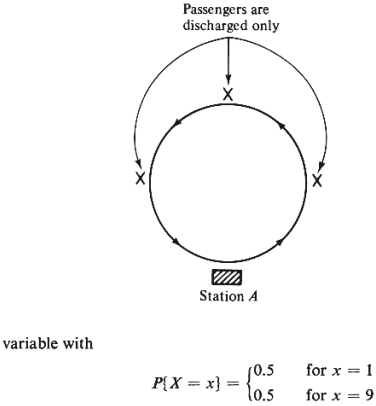4.5 Single-bus transportation system This problem illustrates, once more, one
of the main themes of this book-that the "obvious" thing to do does not always
produce the best results. For several types of urban transportation systems (e.g., buses,
elevator banks, subways, etc.) it is sometimes better to delay some vehicles than to let
them proceed, as soon as possible, with a "trip." This will result in more
regular headways (between the passage of vehicles from stops), which, in turn, improves
overall system performance. Consider as an example the following simple situation. A bus
"system" consists of a single bus that operates on a route (Figure P4.5) with a
single stop (station A) for picking up passengers, who are then delivered to other stops
along the route. (This could be a primitive model for a local bus system in a suburban
community during the evening rush hour. The single pickup stop would be at the train
station where commuters from a central business district return from work.) Define H to be
the headway between successive departures of the bus from station A. Assume that:
1 . The time interval, X, between the instant when the bus leaves station A and the
instant when it returns there for the first time is a discrete random

2. Passengers board the bus instantaneously once it returns to station A and the
capacity of the bus is sufficiently large so that no one is ever left out.
3. Passengers arrive at station A to catch the bus randomly, according to some
probabilistic process which is independent of the location of the bus at any given time.
a. Find the expected time, E[ W], that a random passenger will spend at station A if
the bus always leaves station A immediately after it arrives there and the passengers
board it (instantaneously).
b. Repeat part (a) for the case in which the bus is held at the station for
three extra time units whenever it returns to station A only one time unit after leaving:

Note that E[ W] has decreased now despite the fact that the frequency of bus service
has decreasedas well.
c. Assume that it has been decided to use the dispatching strategy

at station A, where ao is an unknown constant. Determine the value of ao that minimizes
E[ W].
In general, it has been shown that, for any
pdf fx(x) for X, the optimal headway strategy
for this problem is to set H = Max (a*0, X),
where a*0 is the optimal
value of the constant ao (note that X is allowed to be any random variable in this case
but that the result above is limited to single-bus systems).
d. In part (c) you found that a*0
= E*[W], where E*[W] is the minimum value of E[W]. This is not an accident but a
general property of optimal headway strategies for this problem [OSUN 72]. Does this
suggest a good iterative procedure for solving part (c) ?
e. Repeat parts (a) and (c) for the case fx(x) = e-x for
x  0. 0.
A good review and more general results for
problems of this type has been published by Barnett [BARN 78].
|